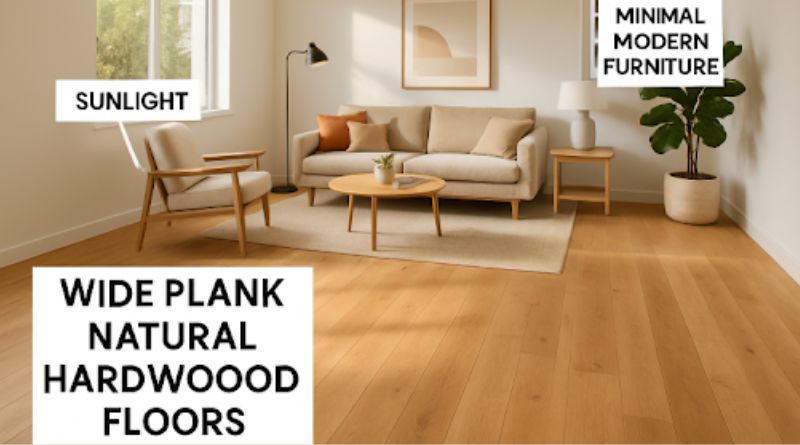Hardwood flooring remains a key element in modern home design, valued for its beauty, durability, and ability to match various styles. As preferences change, homeowners seek floors that boost aesthetics, value, sustainability, and style. Innovations in sourcing, finishes, and layouts make hardwood more customizable. Trends include natural finishes, wider planks, and organic materials to create a comforting home atmosphere. Textured surfaces add depth, reflecting appreciation for natural imperfections. Designers focus on inventive colors and patterns, with an emphasis on responsible sourcing like reclaimed wood. These trends offer practical, unique, yet timeless flooring options.
Embracing Natural Tones
Subtle, organic tones are dominating the hardwood flooring landscape as more homeowners aim to bring nature indoors. Shades such as honey oak, warm maple, light ash, and even muted walnut infuse spaces with tranquility and warmth. These hues create inviting settings and provide a versatile backdrop for various design styles, from Scandinavian minimalism to classic vintage. By focusing on natural colorways, designers can amplify the intrinsic beauty of wood grains, promoting a sense of authenticity and calm. This approach is also adopted by SOEN Hardwood in their thoughtfully crafted flooring selections.
The Appeal of Wide Plank Flooring
Wide plank floors, ranging in width from 5 to 12 inches, offer a luxurious and spacious feel to modern homes. The broader surface showcases the natural wood grain, allowing the material’s history and texture to shine. This choice is particularly effective in open-concept floor plans, where continuity and a sense of connection are desired. Wide planks can make rooms appear larger and less cluttered, while also yielding a modern, seamless appearance prized in both rustic and contemporary settings.
Incorporating Textured Surfaces
Texture is playing an increasingly vital role in the design of hardwood flooring. Modern techniques, such as wire-brushing, hand-scraping, and intentional distressing, create floors with added dimension and personality. Not only do these finishes enhance the visual complexity of a room, but they also serve practical purposes—concealing scratches, dings, and imperfections that may occur in high-traffic homes. Textured surfaces often improve slip resistance as well, making them a smart option for families and pet owners.
Sustainable and Eco-Friendly Choices
Environmental considerations now rank high on the list when selecting hardwood floors. Reclaimed wood, salvaged from barns and old buildings, tells a unique story with every plank, reducing demand for new raw materials. For new hardwood, many consumers insist on products certified by esteemed organizations like the Forest Stewardship Council (FSC), which ensure responsible forestry practices and minimal environmental impact. These mindful selections allow homeowners to align their values with their décor, embracing both design excellence and sustainability.
Matte Finishes for Understated Elegance
Matte and low-sheen finishes are fast overtaking their glossy counterparts in popularity. These finishes impart a subtle, sophisticated look, minimizing glare and reducing the visibility of smudges or scratches—perfect for active households. Matte floors deliver a sense of “lived-in” charm and longevity, supporting contemporary design’s movement toward realistic, approachable luxury.
Creative Patterns and Layouts
The resurgence of classic flooring patterns, such as herringbone and chevron, is adding a stylish appeal to homes, making them feel bespoke and visually captivating. Despite the complexity of installation, these patterns offer a transformative effect by introducing movement and a sense of old-world charm. Additionally, modern homeowners are embracing geometric designs, diagonal layouts, and mixed plank sizes, shifting the floor installation pattern from a fundamental element to a key design feature.
Bold Colors and Patterns
Though natural and neutral tones lead the market, bold and unconventional hues—ranging from ashen blacks to deep jewel tones—are gaining traction among those wanting statement-worthy floors. Used selectively, saturated stains and inlaid designs transform ordinary rooms into unforgettable spaces, especially in entryways, dining rooms, or home offices where homeowners wish to showcase personal flair or sophistication.
Conclusion
Hardwood flooring trends for modern homes reveal a dynamic fusion of tradition and innovation. By embracing natural finishes, investing in sustainable materials, exploring various textures, and experimenting with colors and layouts, homeowners can create resilient, beautiful floors that reflect both contemporary style and enduring elegance. These evolving choices ensure that hardwood remains a defining element of modern interior design—one that brings enduring warmth, value, and style to every space.

